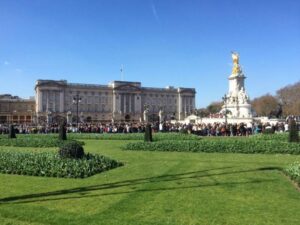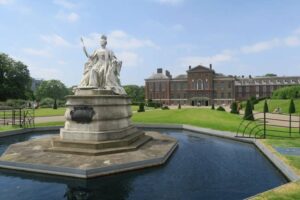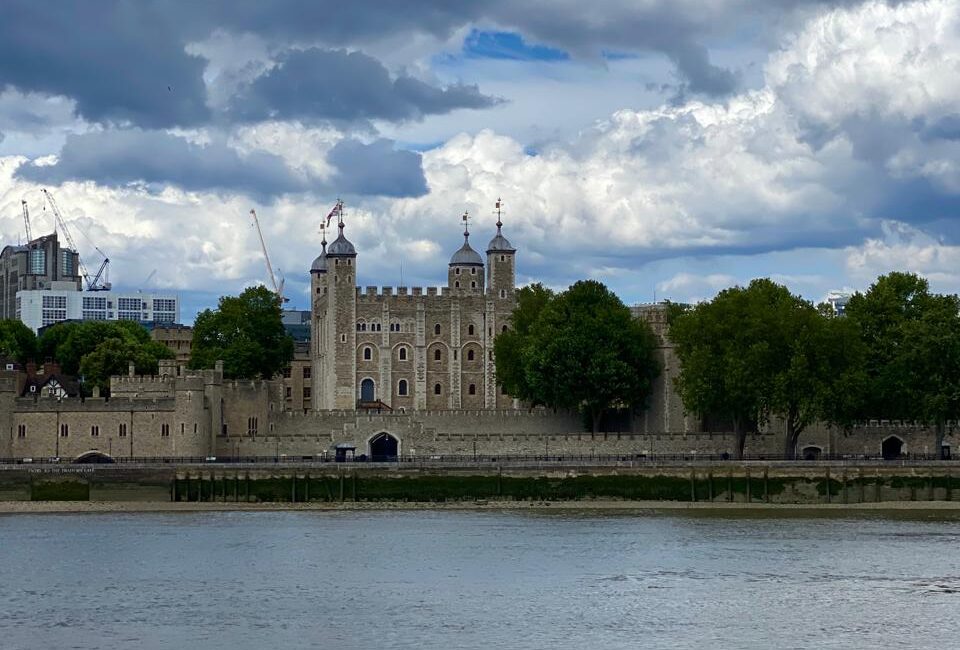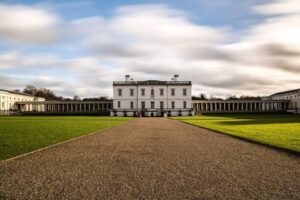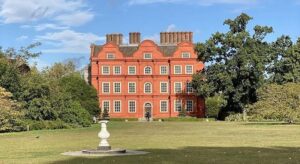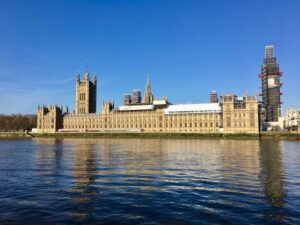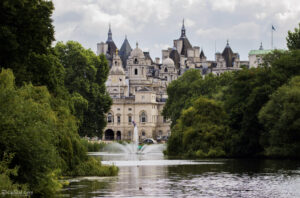British Royal Houses In London
Date post added: 28th December 2024
Where do all the royals live in London? Which royals live in Buckingham Palace? Let us give you the lowdown on the many royal houses in London, and a few favourite residences around the UK.
Royal palaces, mansions, and houses… the buildings occupied and used by the Royal Family are many, dotted around the United Kingdom. London has the largest number of royal family homes in the whole of Britain. From the legendary Buckingham Palace, to the site of power that is the Palace of Westminster and the historic fortress The Tower of London, these royal houses are the sites of centuries of history, ceremony and stories.
Here, we’ll share insights into ten of the finest British royal houses in London.
Buckingham Palace
Buckingham Palace, the official residence of King Charles III, is the largest of all the historic royal palaces and is used as “The Office” for the King and the royal court. The King meets the Prime Minister here weekly and holds official ceremonies and receptions within its grand state rooms. The balcony is famous worldwide – it’s where the royals gather to wave at the crowds on special occasions like royal weddings.
Many people will remember Brian May of the rock band Queen playing ‘God Save The Queen’ from the roof of Buckingham Palace to celebrate 50 years of her monarchy in 2002. Wow! That was a great concert!
The site where Buckingham Palace now stands was originally a mulberry garden planted by King James I. His intention was to rear silkworms there, but he chose the wrong kind of mulberry bush. So, silk production never took off in Britain.
Kensington Palace
Dukes, duchesses, princes and princesses have made Kensington Palace their home with the larger part of the palace complex divided into separate apartments. Back in the 17th century, William III and Mary II commissioned Sir Christopher Wren to transform the then mansion into a suitable royal residence.
Currently, Kensington Palace houses the offices and London residences of The Prince and Princess of Wales, The Duke and Duchess of Gloucester, and Prince and Princess Michael of Kent. Previously, Prince William, the Prince of Wales, and Princess Catherine lived here with their three children, George, Charlotte and Louis. They lived in Apartment 1a, which is grander than it sounds. It’s a 20 room private residence which takes up one wing of the large rear section of Kensington Palace. Princess Margaret, Queen Elizabeth II’s sister, used to live here.
Famously, Kensington Palace was the home of Princess Diana, former Princess of Wales, too. She lived in Apartment 8 after her divorce from King Charles. The spotlight fell on Kensington after her death and it was from here that the funeral cortege left to travel to Buckingham Palace and from there to Westminster Abbey for her funeral. An extremely moving occasion which most who witnessed it will never forget.
Historically Kensington Palace is most linked with Queen Victoria, who was born here. It was here that she learned she was to become queen, here that she held her first government meeting with her privy council and it was here that she met the love of her life, Prince Albert. It is now possible to visit those historic rooms where she lived along with the most impressive state apartments, many of which occasionally feature in period film productions.
St James’ Palace
When Buckingham Palace was bought as Buckingham House for King George III it was thought that the new home would be a place to live, whilst St James’ Palace was for receptions and formal events.
St James’ Palace is now a working palace and is still the official home of the ‘court’. All ambassadors are accredited to the Court of St James. You’ll find the offices of Royal Collection Trust, the Marshal of the Diplomatic Corps, the Central Chancery of the Orders of Knighthood, the Chapel Royal, the Gentlemen at Arms, the Yeomen of the Guard and the King’s Watermen here at St. James’s Palace.
St James’s Palace has provided a convenient London apartment for many royals who live outside London. Prince Charles lived here for a while.
Take a royal walk with us around the Old Palace Quarter to find out more about St James Palace, and so much more.
The Tower of London
The Tower of London is the oldest of the royal palaces in London. Built by William the Conqueror after his conquest of England in 1066, it. was designed to protect London from the eastern approach along the River Thames.
Inhabited by many kings and queens throughout history, The Tower was rarely used as a principal home but was traditionally the place from which the coronation procession started. We now remember it better, of course, as a prison and for beheadings and executions. There are plenty of fabulous stories related to these, such as the beheading of Anne Boleyn in the Tudor times! This is where the Crown Jewels of the United Kingdom are kept and it’s well worth a visit.
Queen’s House
The Queen’s House in Greenwich is a beautiful, yet relatively small building in a stunning location facing the Thames. This was associated with several queens in the 17th Century, being built especially for Queen Anne of Denmark. Sadly she didn’t live long enough to see it finished and so her daughter-in-law, Queen Henrietta-Maria was the queen for whom it was finished. This Queen’s House is open to the public and is a must-see for visitors to Greenwich.
Kew Palace
Out at Kew, in the centre of the stunning Royal Botanic Kew Gardens, is another former royal residence. Originally called the Dutch House, it’s now known as Kew Palace and was the place where King George III and his wife Queen Charlotte loved to spend the summers with their 15 children. Sadly, it also the place where George III was treated by his doctors during his illness or ‘madness’, which plagued him on and off for the last two decades of his life.
The Palace of Westminster
The Palace of Westminster, better known as the Houses of Parliament today, was also once a royal residence. It was last used by King Henry VIII. The current building is much more recent and is now the home of government.
Whitehall Palace, once the largest palace in Europe, also stood nearby but was sadly was destroyed by fire in 1698. Banqueting House is the only part remaining of this huge royal complex and is worth the visit just to see its spectacular ceiling by Peter Paul Rubens.
Hampton Court Palace
King Henry VIII’s favourite royal residence was Hampton Court Palace. His daughter, who later became Elizabeth I lived here too, and was actually held under house arrest at Hampton Court Palace during the reign of her sister Mary I.
Built to be the height of fashion 500 years ago, it offers a double whammy for the visitor. Firstly, the extensive Tudor kitchens, the Royal Chapel and the Great Hall with its amazing ceiling. Look out for the eavesdroppers in the rafters!
Secondly, the rear of the palace was built 200 years later by King William and Queen Mary in an attempt to rival Versailles, home to King Louis XIV of France. Room after room is filled with tapestries, priceless works of art and amazing painted ceilings.
Hampton Court Palace has been open to the public since the time of Queen Victoria and it’s worth making the 45 minute journey out of London. Why not make it a full day by taking strolls through the fabulous palace gardens? You might even see how Real Tennis is played… not so different to when Henry VIII played here.
Clarence House
Clarence House was famously home to Queen Elizabeth, the Queen Mother, for nearly five decades when her daughter ascended to the throne. She loved to hold parties here, along with her daughter Princess Margaret.
Princess Elizabeth and her new husband The Duke of Edinburgh, lived there when they were first married, before the weight of the crown was fixed firmly onto her. And before ascending to the throne, the then Prince Charles lived there with his wife Camilla.
The house on The Mall dates back to 1827 when it was built for the Duke of Clarence (hence the name). Sadly it’s not currently open to the public.
Whitehall Palace
Originally named York House, this was Cardinal Wolsey’s masterpiece. But he made it too rich and sumptuous, so Henry VII coveted it and what Henry VIII coveted… became his royal residence and the most important London palace for a century and a half.
The Banqueting House is the most remarkable aspect. It was designed by Inigo Jones in 1623 and changed English architecture forever. Jones had travelled extensively in France and Italy where he was influenced by ancient Rome and the Renaissance. The result is beyond sensational – a double cube structure with an intricate carved and gilded Reubens ceiling.
It was the chosen site for the execution of Charles I rather than the Tower of London, showing its importance at that time. In 1698 it caught fire – a blaze started by sheets drying over a brazier. Much of the timber structure was destroyed, but the magnificent Banqueting House survived.
Our Tudor Whitehall walk is the perfect opportunity to find out more.
British royal houses outside of London
British royalty has many palaces they call home, mainly across England and Scotland. This is where they escape from the eye of the public and enjoy family time.
Windsor Castle
Windsor Castle has been a fortress for 900+ years, and is a working castle today. Many people receive their medals and honours there. The castle also houses much of the Royal Collection of art. It’s said that the late Queen Elizabeth II preferred Windsor Castle, just outside of London, to Buckingham Palace. She tended to live there at weekends and throughout Easter.
St George’s Chapel is the burial site for many English royals including Queen Elizabeth II and her husband, Prince Phillip, as well as her sister, Princess Margaret. St George’s Chapel is a Royal Peculiar. It’s not subject to a bishop or archbishop but which owes its allegiance directly to the Sovereign. You can attend a service there daily.
Sandringham House
Sandringham Estate is in the Norfolk coast area is a country retreat of the monarchy. The King and Queen Camilla spend time there, enjoying the organic farm and rural surroundings.
It was private home of the late Queen. When he retired, the late Prince Philip, the Duke of Edinburgh, lived in Wood Farm on the estate. Since 1988, the members of the royal family have been gathering on Christmas Day at Sandringham.
Highgrove House
Highgrove, situated in Gloucestershire, is the private residence of King Charles III and Queen Camilla. The King first lived at Highgrove in 1980 and Prince William and Prince Harry spent most of their childhood there. King Charles III created wild gardens which now attracts 30,000 people annually. They’re renowned for being some of the most inspiring and innovative in the United Kingdom.
Balmoral Castle
This private country house located in Scotland’s Highlands has been the cherished home of the British Royal Family since 1852. The late Queen spent her summer break at Balmoral each year, and it was here that she spent her final days until she died. It was originally purchased for Queen Victoria by Prince Albert in 1852.
Discover the stories beyond the palace walls
If you love stories of royal shenanigans, you must join our Past the Palace Walking Tour. Don’t expect to gaze up at Buck House though. On this guided tour, you get to see the nitty gritty of royal hideaways and boltholes. Oh and the stories you’ll hear! Our guides love to share fascinating tales and they’re so very good at it.

